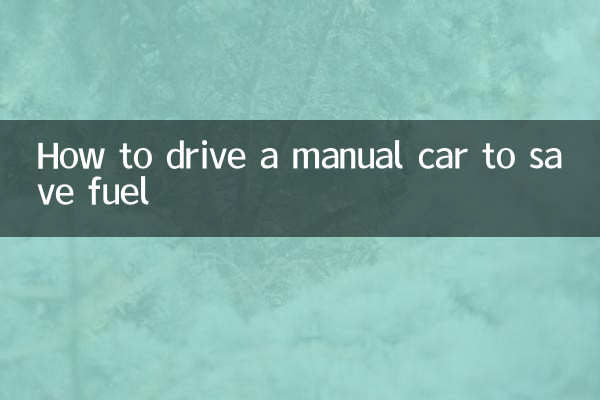How to drive a manual car to save fuel
Today, as oil prices continue to rise, how to save fuel has become the focus of many car owners. Due to their flexible control and high transmission efficiency, manual transmission vehicles can significantly reduce fuel consumption when driven appropriately. This article will combine the hot topics and hot content on the Internet in the past 10 days to summarize practical tips for saving fuel in manual transmission vehicles, and present it in the form of structured data.
1. The core principles of manual transmission to save fuel

The key to saving fuel in a manual transmission vehicle is to reasonably control the engine speed and gear shifting timing to avoid unnecessary fuel consumption. Here are three core principles for fuel efficiency:
| in principle | illustrate |
|---|---|
| Smooth acceleration | Avoid slamming on the accelerator and keep driving at a constant speed |
| Shift gears in time | Choose the appropriate gear according to vehicle speed and road conditions |
| Reduce idle speed | Turn off the engine when parked for a long time to avoid idling and consuming fuel |
2. Specific fuel-saving techniques
1.Reasonable shifting timing
The timing of shifting gears in manual transmission vehicles has a great impact on fuel consumption. The following is the recommended shift speed range:
| Gear | Recommended shift speed (RPM) | Corresponding vehicle speed (km/h) |
|---|---|---|
| 1st gear up to 2nd gear | 2000-2500 | 15-20 |
| 2nd gear to 3rd gear | 2000-2500 | 30-40 |
| 3rd gear to 4th gear | 2000-2500 | 40-50 |
| 4th gear to 5th gear | 2000-2500 | 60-70 |
2.Use coasting
When going downhill or when you need to slow down ahead, you can release the accelerator in advance and use the vehicle's inertia to coast. At this time, the engine is in a fuel-cut state, which can effectively save fuel. But please pay attention to safety and do not slide in neutral.
3.Maintain proper tire pressure
Insufficient tire pressure increases rolling resistance and increases fuel consumption. It is recommended to check tire pressure once a month and keep it at the manufacturer’s recommended value:
| car model | Front tire pressure (bar) | Rear tire pressure (bar) |
|---|---|---|
| compact car | 2.2-2.4 | 2.2-2.4 |
| mid-size sedan | 2.3-2.5 | 2.3-2.5 |
| SUV | 2.4-2.6 | 2.4-2.6 |
4.Reduce vehicle load
For every 100kg increase in vehicle weight, fuel consumption will increase by approximately 5%. It is recommended to clean unnecessary items in the trunk regularly and avoid carrying overweight items.
3. Other matters needing attention
1.Regular maintenance
Good vehicle condition is the basis for fuel economy. It is recommended to regularly replace the engine oil, air filter, etc. according to the maintenance manual to maintain the best working condition of the engine.
2.Proper use of air conditioning
Air conditioning will significantly increase fuel consumption. It is recommended to open windows for ventilation when the vehicle speed is lower than 60km/h, and use air conditioning when driving at high speed.
3.Plan a driving route
Planning routes in advance, avoiding congested roads, and reducing frequent starting and braking can effectively reduce fuel consumption.
4. Fuel-saving tips under different road conditions
| road conditions | Fuel saving tips |
|---|---|
| urban congestion | Keep distance between cars and avoid sudden braking; use 2-3 gears at low speeds |
| highway | Maintain a constant speed and use the highest gear; control the vehicle speed at 90-100km/h |
| mountain road | Accelerate appropriately before going uphill; use engine braking when going downhill |
5. Summary
The key to saving fuel in a manual transmission vehicle is to develop good driving habits, reasonably control the gear and speed, and keep the vehicle in good condition. Through the above tips, it is expected to reduce fuel consumption by 10%-20%. I hope the content of this article can help car owners enjoy driving while also saving fuel expenses.
Recent hot topics show that with the popularity of new energy vehicles, the use skills of traditional fuel vehicles are still receiving widespread attention. Mastering these fuel-saving tips can not only save money, but also reduce carbon emissions and contribute to environmental protection.

check the details

check the details